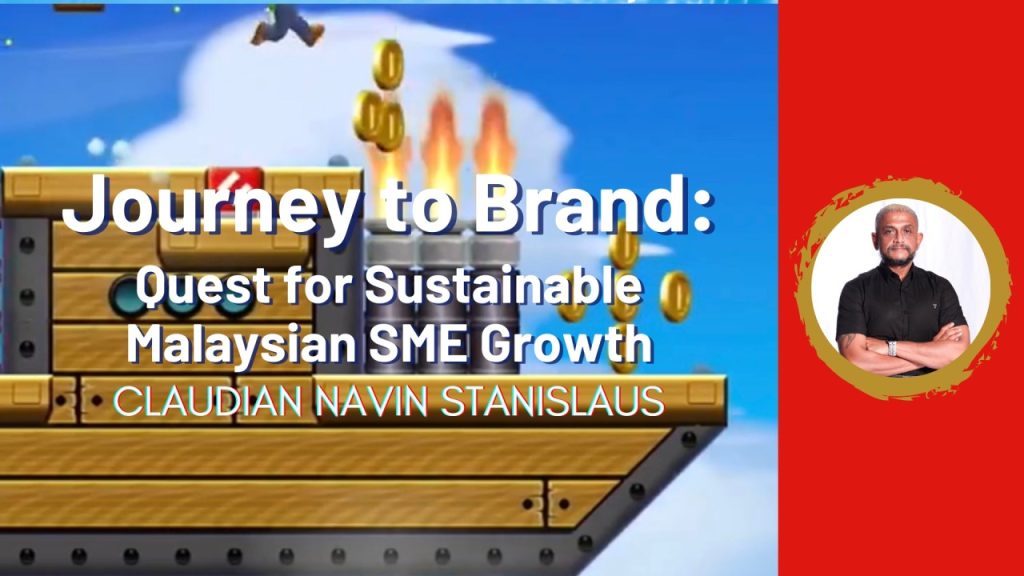BY CLAUDIAN NAVIN STANISLAUS – PRESIDENT, MALAYSIAN ADVERTISERS ASSOCIATION
In the vibrant and dynamic economic landscape of Malaysia, Small and Medium Enterprises (SMEs) are vital to the nation’s innovation and growth, contributing almost 40% to the Gross Domestic Product (GDP) and nearly 50% of our total employment. Yet, on the fringes of a recent ministerial dialogue with industry leaders, a crucial question was raised about the seemingly entrenched focus on risk mitigation and operational efficiency over more transformative strategies that amplify revenue and market presence of the SMEs, especially at a time when new bilateral agreements offer greater promise along with the challenge of cross border competition.
Should there not be a shift in focus? Sustainable growth isn’t just about cost-cutting or risk mitigation
Should this pivotal moment not call for a shift in focus? Sustainable growth isn’t just about cost-cutting; it’s about creating a distinguishable unique value and carving out a distinct presence, that resonates with the marketplace.
Lately, there’s been a notable surge of SMEs branching out into services and solutions, riding the wave of national focus on the Environmental, Social, and Governance (ESG) and digital transformation agenda. However, for most other businesses, this focus doesn’t pay the bills – it adds to them!
If we give them the funds, they’ll use it for something else
A candid response, “You know they don’t believe in it. If we give them the funds (for building brands), they’ll use it for something else”, illuminated the prevalent skepticism towards the SME community’s willingness to embrace brand building as a strategic avenue for growth.
This skepticism is not without basis. In my interactions with SME business leaders, I’ve noticed a common thread, despite the universal respect for SMEs that have become recognisable brands and have seen sustained growth, many doubt they can replicate this success in their own businesses.
Let’s Imagine the entrepreneurial journey as a video games, and call it ‘SMEquest’
Imagine the entrepreneurial journey as one of those platform video games. Let’s call it “SMEquest”. Here, SMEs, our intrepid hero, navigate through levels, accumulating points (income), tokens (accolades), and powers (growth) by tackling challenges, seizing opportunities, and breaking through barriers to level up. Yet, as they progress, the game’s complexity intensifies—optimizing operations, reducing costs, and boosting revenue becomes increasingly formidable. For those unprepared, there’s always a risk of getting knocked back down a level – even losing the game!
Some SMEs might choose to remain in comfortable levels, accumulating points and accolades, opting for strategies like price discounting to maintain their position. However, there’s a price to pay on this route, a hefty one in the long-term. It risks commoditisation, leading to the downward spiral of relentless price wars that are never won, resulting only in ever-diminishing returns.
Brand building equips SMEs with shields and power-ups
Brand building, akin to acquiring shields and power-ups in our gaming analogy, equips SMEs with the means to stand out, protect their ventures, but more importantly to provide leverage in overcoming hurdles and the boost required to break through to new levels. A compelling brand serves as the ultimate differentiation tool, navigating businesses through economic downturns and escalating competition. An alluring value proposition can even qualify the premiumisation of prices, insulating the business from price wars.
This strategic approach, transcending mere aesthetics, can position SMEs as the preferred choice by crafting resonant stories that foster trust, loyalty, and drive sustainable growth. It’s a strategic imperative that transcends mere utility of products or services, crucial for any business aiming to venture beyond their geographical limits, but also, ever more essential for any business to remain resilient and emerge stronger, amidst today’s geoeconomic climate.
It is not mere conjecture or theoretical there’s numerous success stories of SMEs, achieving phenomenal growth
It is not mere conjecture or theoretical either; numerous success stories abound of SMEs, globally and locally, that have leveraged on creating brand value to achieve phenomenal growth and even global market penetration – a local spice brand undoubtedly comes to mind!
So, why are many SMEs still slow to make that transition from a transactional business into a value-centric brand?
This hesitance, while understandable, shouldn’t be acceptable. It often stems from what can be a daunting task of deciphering the complexities of brand strategy (not to mention keeping up with the loads of fresh jargon that’s churned out regularly!) with their limited resources. Almost everyone’s also has some memory of some ill-advised previous ‘experiment’ too. Which yielded some sexy visuals, but no quantifiable strategic outcomes.
Branding is an investment in business resilience
It’s high time to debunk some of the myths and misconceptions that fuel this hesitation. However, the reality diverges; it’s not a trip to the races or the poker table. Branding is often perceived as a costly, high-risk venture exclusive to deep-pocketed corporates. These corporations and large brands are not just callously gambling but making informed business decisions. All business decisions carry risk, mitigated through strategic planning based on insights. In fact, it’s often SMEs who would invest in the riskier venture, buying into that ‘too good to miss’ deal, that’s obviously too good to be true!
While it’s undeniable that larger brands invest more in branding, it’s also true that you notice them because they do. What may not be immediately visible are the brands that are flying under your specific radar, who are invested in brand building and effectively sustaining their growth. You don’t notice them simply because they are investing more prudently, focusing their efforts to reach more immediate customers that may not include you.
Historically, such challenging times have been fertile grounds for nimble SME players to seize the opportunities
Often, we are shocked when a brand appears from nowhere, but later realise that they’ve been around for a while. These are examples of brands that have been strategic in focus, gradually building their brands and doubling efforts with each level breached. They do what they can with what they have, knowing that as with all things, expectations must be practical. Strategic brand positioning, rooted in authenticity and a deep understanding of the target audience, can yield significant returns, even on the modest investments. You just need to know your audience, how to engage them and manage your expectations as you manoeuvre through each new level – there are no shortcuts!
Historically, such challenging times as we see today, has seen more established brands either scaling back or reaping the rewards of a buyer’s market, getting more ‘bang for their buck’. What shouldn’t be overlooked however, is that such times have been fertile grounds for nimble SME players adeptly platforming these challenges to seize the opportunities to sow the seeds of their brands, sprout, bud or bloom, depending on their readiness.
The juncture for SME brands has never been more imminent and immediate
When this is taken inconsideration with the efforts of Malaysia and its ASEAN counterparts for greater economic collaboration, and all the Free Trade Agreements (FTAs) being put into motion, the juncture for SME brands has never been more imminent and immediate, especially if we contemplate the threat of competitive encroachments that the open market likewise brings.
The role of SMEs as brands becomes increasingly vital, not as some isolated endeavor but as a holistic approach that positions SMEs in the hearts and minds of its customers. It need not be something seen by all, but it must be felt by the customers that matter to you. This value proposition that defines a brand is more marketable than any product on its own and can make the leap to new territories too.
Malaysia’s multicultural kaleidoscope offer SMEs unique branding perspectives, tapping into shared cultural heritage and values
Here, the concept of the Asian Brand Alchemy or the intrinsic Asianness (that I’ve previously discussed), that leverages on Malaysia’s vibrant multicultural kaleidoscope, makes it a unique crucible of continental culture, values, and subtleties, that can further offer our SMEs unique branding perspectives. This approach is not merely an add-on but a strategic imperative, differentiating our SMEs in new and crowded regional and global marketplace by tapping into our shared cultural heritage and values.
So, what is needed to ensure that brands see the ‘light’? The journey to brand requires understanding that brand building extends beyond logos or flashy campaigns. It’s about the lasting impressions these efforts leave on customers, defining the perceived value of your business to them!
Brands act as differentiators when products become interchangeable in the eyes of the customer
Strong brands act as differentiators when products or services become interchangeable in the eyes of the customer, but seeing beyond this immediate potential, it opens doors to new markets, fosters customer advocacy, and creates a sustainable competitive advantage. It will necessitate a commitment to understanding the market though, investing in authentic customer connection, and consistently nurturing trust.
Branding therefore should be seen not as a marketing expense but as a critical investment in business resilience, building relationships, and consistently delivering on expectations!
The misconception that branding is solely for consumer-centric businesses is another myth needing debunking. All businesses benefit from strong brand relationships – whether their customers are consumers, or other businesses.
There’s almost 40% of the nation GDP of about USD 1.382 trillion contributed by the sector. In exports alone, close to RM145 billion. You do the math!
A critical alignment needed is the accessibility of branding expertise. Established media, digital and creative agencies and tech vendors must extend more affordable solutions and be more approachable to the SME sector, realising that for their own survival and growth is going to require the existing pool of brands to constantly be expanding. The biggest potential pool of these is lying dormant or trying to find its way, platforming the levels of this complex landscape alone, or worse, falling prey to less scrupulous practitioners. That’s almost 40% of the nation GDP that’s largely untapped. World Economics estimates Malaysia’s GDP to be $1.382 trillion. In exports alone the SME sector contributed close to RM145 billion. You do the math!
It doesn’t hurt as a way to prove your worth as a partner to these potentially new SME brands (and prospective customers!) during these challenging times.
For any such collaboration to work, customers must be reachable, and this is where a realignment is required from the media owners too!
Rather than looking solely on transactions, media owners should use their network and expertise to provide a ‘proof of concept’, that could entice a ‘domino effect’
Rather than looking solely on transactions, offering bundles and airtime promotions, local media owners should focus their strengths to work towards curating personalised programmes that specifically enable local SMEs to translate the brands values to a proposition that best suits your specific audiences. This does not have to be open ended, which would neither be in their interest or effective, but rather by focusing on uplifting selected SME businesses from various sectors and effectively using their network and expertise to provide a ‘proof of concept’, that could entice others in these sectors to emulate, causing a ‘domino effect’.
While industry serving industry is a noble idea, one that we would undoubtedly all willingly support in the name of national interest; as business entities, for this to truly work, the realigning of governmental support would be the most paramount, to hold all the pieces together. This could be achieved by supporting the media owners with grants for their programmes to offset the cost that SMEs might be hesitant to invest in otherwise, but with clear and transparent processes that ensure the “money is not used for something else”!
‘SME Credits’; likened to ‘carbon credits’, could be earned for campaigns for SMEs
The agencies and vendors could perhaps benefit from some form of rebates and incentives too, to offset their costs in support the development of SME brands. I have in the past suggested the idea of ‘SME Credits’ that they would earn; likened to ‘carbon credits’, for each campaign they propose and execute (based on incremental budget levels) for SMEs.
These could be made redeemable and transferable creating additional value for participating agencies too. Being an emergency action with the intention of boosting the sector and economy through this challenging time, it should only be a short-term initiative, which can be repeated periodically, as and when the need is identified.
Government shouldn’t be expected to give something to everyone, but not serve to achieve anything for anyone in reality
Coming full circle, it’s the businesses and brands in the SME sector that would need to be supported in earnest, if they’re meant to not just survive but thrive!
For the ‘domino effect’ to persist, the government shouldn’t be expected to fund grants that give something to everyone but will not serve to achieve anything for anyone in reality.
An actionable joint governmental and industry study could explore the feasibility of a ‘Cash Back for Branding’ programme, or more immediately at reducing the transactional cost of brand building initiatives. In order to achieve a higher volume of taxable revenue for the government, these initiatives could optimally be expanded to include all Malaysian brands and businesses, but strictly as a short-term effort to encourage the SMEs own investments in such far-reaching initiatives. This would not only ensure the fluidity of the local marketing industry’s support sector but will more importantly enable Malaysian SMEs to prime themselves for expansion beyond these shores.
This quest is about unlocking potential, breaking barriers, and setting Malaysia’s own brand as a hub for SME brand excellence
Whatever the eventual solutions may be, there’s a need for a collective call to action for SMEs, agencies, media owners, and the government to work together towards accessible, effective solutions that foster a conducive environment for SMEs to not just survive but flourish, for the marketing industry to be ignited again – and for the government to earn from the volume in taxable revenue generated.
Let’s draw inspiration from the video game analogy, recognising that with the right strategies, support, and determination, SMEs can overcome each level of challenges and seize the opportunities emerging victorious, setting new benchmarks for success both regionally and globally. This quest is about unlocking potential, breaking barriers, and setting Malaysia’s own brand as a hub for SME brand excellence in the ASEAN region and beyond.
Together, we can catalyze a transformative shift in the SME sector, empowering Malaysian businesses to not just compete but lead on the regional, if not global stage. With strategic brand building at the helm, we ensure our SMEs craft legacies that transcend borders and generations. Let’s unite in this cause, leveraging the unique collective strengths of our diverse ecosystem to propel Malaysian SMEs into a future where they don’t just compete—they lead.
Sourced from LinkedIn
MARKETING Magazine is not responsible for the content of external sites.










